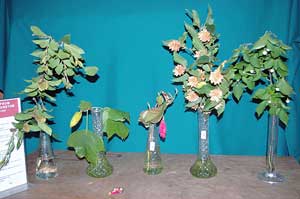September Color Appears at the Washington Park Arboretum
“Ornamental Late Summer Fruits”

1) Betula lenta (Sweet Birch)
- The fruit, maturing in fall, is composed of numerous tiny winged seeds packed between the catkin bracts.
- Twigs, when scraped, have a strong scent of oil of wintergreen.
- Several specimens are located east of Azalea Way bordering the wetland bog.
2) Liriodendron tulipifera (Tulip Tree)
- The fruit is a cone, two to three inches long, made of a great number of thin narrow scales attached to a common axis. These scales are each a carpel surrounded by a thin membranous ring.
- Another eastern North American tree which is also considered the tallest deciduous angiosperm in the world.
- A mature grove is located in our Magnolia Collection.
3) Magnolia sieboldii (Oyama Magnolia)
- The ornamental three-inch-long carmine fruit dangles off the tree, and eventually busts open to reveal orange “alien” seeds from “outer space”. The fruit are oval in shape and have little spine-like points that create an interesting texture.
- Shrub native to eastern Asia in China, Japan, and Korea.
- Located just outside the west entrance to the Graham Visitor Center.
4) Ostrya carpinifolia (Hop Hornbeam)
- The fruit form in pendulous clusters, 3-8 cm. long with 6–20 seeds; each seed is a small nut 2–4 mm. long, fully enclosed in a bladder-like involucre.
- Small tree native to Europe.
- Specimen is located in Hornbeam section, just past the Broadmoor service entrance on Foster Island Road.
5) Styrax japonicus (Japanese Silverbell)
- The fruit is an oblong dry drupe, smooth and lacking ribs or narrow wings, unlike the fruit of the related snowdrop trees (Halesia) and epaulette trees.
- Mature specimens may be found half-way down Azalea Way on the west side.